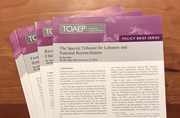Table of contents:
M.P.1. The perpetrator had knowledge of a fact of which the person was ignorant.
M.3.1.2. Evidence of the predominance of the perpetrators will over that of the person or persons.
M.P.3. Evidence of the perpetrators inherently predominant will.
M.P.3.1. Evidence that the person was a minor.
M.P.3.2. Evidence of mental disease or defect on the part of the person.
M.P.3.3. Evidence of intoxication on the part of the person.
M.P.4. Evidence of the perpetrators predominance by way of a hierarchical organisational structure.
M.P.5. Evidence of the perpetrators predominance by way of the use or threat of force.
M.P.6. Evidence that the perpetrator gave instructions directly to the person.
Element:
A. Evidentiary comment:
According to E. Van Sliedregt, the indirect perpetrator may be the auctor intellectualis of the crime. "The division is then 3(a) for perpetrators, physical, joint or by means. For instance, the auctor intellectualis, (b) for mid-level and lower level participants c) for mere facilitators and assistants, d) those involved in group crime."). (Elies Van Sliedregt, The Criminal Responsibility of Individuals for Violations of International Humanitarian Law (2003), p. 114).
The indirect perpetrator must sufficiently dominate the agent, or in other words, exert a controlling predominance over the agent, so as to justify attributing to him the conduct of the latter as though it were his own. (Kai Ambos in Triffterer (ed.), Commentary on the Rome Statute of the International Criminal Court, article 25, para.9; A. Eser in: Cassese et al. (eds.), vol. 1, p. 793 and 794).
There must exist sufficiently tight control by the indirect perpetrator over the direct perpetrator, similar to the relationship between superior and subordinate required for superior responsibility. (Kai Ambos in Triffterer (ed.), Commentary on the Rome Statute of the International Criminal Court, article 25, para. 9).
M.P.1. The perpetrator had knowledge of a fact of which the person was ignorant.
Elies Van Sliedregt, The Criminal Responsibility of Individuals for Violations of International Humanitarian Law (2003), p. 71:
"Take the example of the bomber pilot who drops poisoned bombs, but who is unaware of their poisonous content. Employing poisoned weapons is a war crime under Article 8(2)(b)(xviii) of the ICC Statute. When it can be shown that the superior manipulated the pilot in that he know that the weapons contained poison, but assured his subordinate that they were clean and thus used his subordinate as an instrument in employing those weapons, the superior can be held responsible as an indirect perpetrator (a principal) by perpetration of means."
A. Legal source/authority and evidence:
George P. Fletcher, Rethinking Criminal Law (1978), p.639:
"Suppose A gives a child B an innocuous-looking poison to put in the intended victims food. If the child carries out the request, the perpetrator is A, not B."
B. [Evidentiary comment:]
A. Legal source/authority and evidence:
George P. Fletcher, Rethinking Criminal Law (1978), p. 670:
[Citing Judgment of June 10, 1952, 3 BGHSt. 4 and StGB §239]:
B. [Evidentiary comment:]
M.3.1.2. Evidence of the predominance of the perpetrators will over that of the person or persons.
M.P.3. Evidence of the perpetrators inherently predominant will.
M.P.3.1. Evidence that the person was a minor.
A. Legal source/authority and evidence:
J.C. Smith, Smith and Hogan. Criminal Law, London/Edinburgh/Dublin (1996), in Elies Van Sliedregt, The Criminal Responsibility of Individuals for Violations of International Humanitarian Law (2003), p. 69:
"The actus reus may be directly brought about by the act of someone who is not a participant in the crime at all (that is, who has no mens rea, or who has some defence, such as infancy or insanity). Such a person is usually described as an innocent agent and, in such a case, the principal is the participant in the crime whose act is the most immediate cause of the innocent agents act."
B.[Evidentiary comment:]
M.P.3.2. Evidence of mental disease or defect on the part of the person.
A. Legal source/authority and evidence:
J.C. Smith, Smith and Hogan. Criminal Law, in Elies Van Sliedregt, The Criminal Responsibility of Individuals for Violations of International Humanitarian Law (2003), p. 69:
"The actus reus may be directly brought about by the act of someone who is not a participant in the crime at all (that is, who has no mens rea, or who has some defence, such as infancy or insanity). Such a person is usually described as an innocent agent and, in such a case, the principal is the participant in the crime whose act is the most immediate cause of the innocent agents act."
B. [Evidentiary comment:]
M.P.3.3. Evidence of intoxication on the part of the person.
A. Legal source/authority and evidence:
George P. Fletcher, Rethinking Criminal Law (1978), p.669 (quoting S. Kadish and M. Paulsen, Criminal Law and Its Processes, p. 294):
"Suppose two felons are holed up in a house and engaged in a gun battle with surrounding police. One felon tells the other to run for it out the back door where the coast is clear. He does this because he wants the other felon dead and he knows the police have the back door we-covered. As the other felon dashes out, gun in hand, he is shot by police. [...] The critical factor is that the deceiving felon not only dominates, but orchestrates the events leading to the death of his confederate. This is the paradigmatic case of hegemony over the act of an unsuspecting instrument. The surviving felon is held not on a theory of derivative liability, but of perpetration-by-means."
B.[Evidentiary comment:]
M.P.4. Evidence of the perpetrators predominance by way of a hierarchical organisational structure.
A. Legal source/authority and evidence:
Federal Criminal Court of Appeals for the Federal District of Buenos Aires, Case No. 13 (Juntas Trial), Judgment, 9 December 1985, 8 Human Rights Law Journal, 415-417:
"The domination of the indirect perpetrator over the direct perpetrator must be absolute, meaning that if a subordinate refused to obey, he would be automatically replaced by another, who would conform to the indirect perpetrators directives."
Elies Van Sliedregt, The Criminal Responsibility of Individuals for Violations of International Humanitarian Law (2003), p. 70:
"The direct perpetrator loses transcendence as he plays a secondary role in the execution of the act. He who dominates the system dominates the anonymous will of all the men who constitute it."
B. General evidentiary comment:
The active ordering of a subordinate to commit a crime is illustrative of a typical case of perpetration by means by manipulating a hierarchical power structure in terms of organisational predominance. While article 28 covers the offence of omission in a case of commanders not preventing crimes by subordinates, the superior who is in the position to order the commission of the crime is advanced to the rank of an intermediate perpetrator in the sense of committing a crime through another person. (A. Eser in A. Cassese, P. Gaeta and J.R.W.D. Jones (eds.), The Rome Statute of the International Criminal Court, vol. 1, p. 787 and 797).
M.P.5. Evidence of the perpetrators predominance by way of the use or threat of force.
M.P.6. Evidence that the perpetrator gave instructions directly to the person.
A. Evidentiary comment:
There must be evidence of a direct line of communication between the superior and his subordinate. (A. Eser in A. Cassese, P. Gaeta and J.R.W.D. Jones (eds.), The Rome Statute of the International Criminal Court, vol.1, (2002), p 795.)
A. Legal source/authority and evidence:
Federal Criminal Court of Appeals for the Federal District of Buenos Aires, Case No. 13 (Juntas Trial), Judgment, 9 December 1985, 8 Human Rights Law Journal, 415-17. Emphasis added:
"The criminal acts perpetrated by the subordinate officers were always under the control of the defendants, hence they must answer as indirect perpetrators even if some of the direct perpetrators can be exempt from criminal responsibility".







